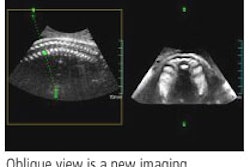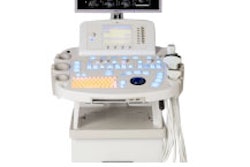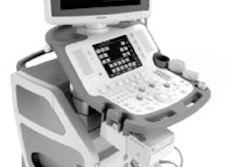WASHINGTON, DC - A focused ultrasound exam may be appropriate for some musculoskeletal sonographic examinations, but it depends on the particular anatomy being studied, according to research presented at the American Institute of Ultrasound in Medicine (AIUM) annual meeting.
"For the shoulder and hip, a routine protocol should be used," said Tracy Boon, an ultrasonographer in the musculoskeletal division of the department of radiology at the University of Michigan Hospitals in Ann Arbor, MI. "For the wrist and hand, the ankle and foot, and probably the elbow and calf, a focused examination may be appropriate. For other requests, a routine protocol should be used."
To test whether presenting symptoms can successfully direct the sonographic exam, a team of four sonographers studied 602 consecutive patients (266 men, 336 women) between July and December 2005. The patients ranged in age from 18 to 96.
All four sonographers used the same scanning protocols for each of the areas examined, and scanned using a 7-15 MHz linear-array transducer with either an HDI 5000 (Philips Medical Systems, Andover, MA) or a Logiq 9 (GE Healthcare, Chalfont St. Giles, U.K.) scanner.
All patients were asked to indicate a focal point of discomfort at the end of the routine study. Of the 499 patients with sonographic pathology, 262 did not have a focal point of discomfort with an abnormal finding at ultrasound, and 224 had a focal point of discomfort with a corresponding abnormal finding during routine ultrasound. Thirteen patients had a focal point of discomfort corresponding with an ultrasound abnormality that was not identified during a routine scanning protocol.
The researchers found that while the focused exam is quick and efficient, it may not identify all pathology, Boon said. A global exam is also helpful when you're learning to scan, she added.
For ankle/foot and wrist/hand studies, a focused exam would have identified more than 70% of abnormalities and more than 60% of abnormalities for elbow/calf, Boon said.
"A focused exam is more effective with superficial structures," she said.
But a focused exam could not be relied on for shoulder and hip exams, Boon said. An unexpected result was in thigh studies, where 76% had a focal discomfort and a corresponding abnormality.
"As this was a large body part, we had expected the opposite result," she said.
The findings may be due to the types of abnormalities encountered, including masses, fluid collections, and hamstring tears, Bood said. They may also be impacted by the small number of cases in the study.
There were no significant differences between focused and complete examinations for knee studies, she said.
Boon acknowledged limitations of the research, including the number of exams for some of the body parts studied, the varying level of musculoskeletal experience among the sonographers, the retrospective nature of the study, and the lack of pathologic proof for many of the cases.
The scanning approach needs to be tailored to the body part being examined, Boon concluded.
"And I can't express this enough: Always scan over the point of discomfort or pain regardless," she said.
By Erik L. Ridley
AuntMinnie.com staff writer
March 26, 2006
Related Reading
US-guided needle tenotomy benefits tennis elbow, January 24, 2006
Osteopath proselytizes for musculoskeletal US, November 11, 2004
Musculoskeletal ultrasound on the rise, may yield cost savings, January 31, 2003
US-guided needle therapy provides quick relief for joint injuries, December 5, 2002
Copyright © 2006 AuntMinnie.com



















